Points of Contact
Revision Information
R.1 Revision SAM-5r00 (24 September 2008)
R.2 Revision SAM-5r01 (28 January 2009)
R.3 Revision SAM-5r02 (22 July 2009)
R.4 Revision SAM-5r03 (18 November 2009)
R.5 Revision SAM-5r04 (20 January 2010)
R.6 Revision SAM-5r05 (19 May 2010)
Contents
Tables
Figures
Foreword
Introduction
SCSI standards family
1 Scope
1.1 Introduction
2 Normative references
2.1 Normative references
2.2 Approved references
2.3 References under development
2.4 Other references
3 Definitions, symbols, abbreviations, and conventions
3.1 Definitions
ACA command:
additional sense code:
aggregation:
application client:
argument:
association:
attribute:
auto contingent allegiance (ACA):
background operation:
blocked command state:
blocking boundary:
byte:
class:
class diagram:
client-server:
client:
command:
command descriptor block (CDB):
command identifier:
command priority:
command standard:
completed command:
confirmation:
confirmed SCSI transport protocol service:
constraint:
copy manager:
current command:
deferred error:
dependency:
dependent logical unit:
device model:
device server:
device service request:
device service response:
domain:
dormant command state:
enabled command state:
extended logical unit addressing:
faulted I_T nexus:
faulted task set:
faulting command:
field:
generalization:
hard reset:
hierarchical logical unit:
I_T nexus:
I_T nexus loss:
I_T nexus loss event:
I_T_L nexus:
I_T_L_Q nexus:
I_T_L_Q nexus transaction:
I_T_L_x nexus:
I/O operation:
implementation specific:
incorrect logical unit number:
incorrect logical unit:
initiator port identifier:
initiator port name:
instance:
in transit:
implicit head of queue:
layer:
link:
logical unit:
logical unit inventory:
logical unit name:
logical unit number (LUN):
logical unit reset:
logical unit reset event:
multiplicity:
name:
nexus:
non-faulted I_T nexus:
object:
object diagram:
operation:
peer entities:
power cycle:
power loss expected:
power loss expected event:
power on:
power on event:
procedure:
procedure call:
protocol:
queue:
receiver:
reference model:
relative port identifier:
request:
request-response transaction:
reset event:
response:
role:
SCSI application layer (SAL):
SCSI device:
SCSI device name:
SCSI event:
SCSI I/O system:
SCSI initiator device:
SCSI initiator port:
SCSI port:
SCSI port identifier:
SCSI target device:
SCSI target port:
SCSI transport protocol layer (STPL):
SCSI transport protocol service confirmation:
SCSI transport protocol service indication:
SCSI transport protocol service request:
SCSI transport protocol service response:
SCSI transport protocol specific:
sender:
sense data:
sense key:
server:
service:
service delivery failure:
service delivery subsystem:
service delivery transaction:
standard INQUIRY data:
target port identifier:
target port name:
task:
task attribute:
task management function:
task management request:
task management response:
task manager:
task router:
task set:
task tag:
transaction:
unconfirmed SCSI transport protocol service:
well known logical unit:
well known logical unit number (W-LUN):
3.2 Acronyms
3.3 Keywords
invalid:
mandatory:
may:
may not:
obsolete:
option, optional:
prohibited:
reserved:
restricted:
shall:
should:
vendor specific:
3.4 Editorial conventions
3.5 Numeric conventions
3.6 Notation conventions
3.6.1 UML notation conventions
3.6.1.1 Notation conventions overview
3.6.1.2 Constraint and note conventions
3.6.1.3 Class diagram conventions
3.6.1.4 Object diagram conventions
3.6.2 Notation for procedure calls
3.6.3 Notation for state diagrams
4 SCSI architecture model
4.1 Introduction
4.2 Compliance requirements
4.3 The SCSI distributed service model
4.4 The SCSI client-server model
4.4.1 SCSI client-server model overview
4.4.2 Synchronizing client and server states
4.4.3 Request/Response ordering
4.5 The SCSI structural model
4.6 SCSI classes
4.6.1 SCSI classes overview
4.6.2 SCSI Domain class
4.6.3 Service Delivery Subsystem class
4.6.4 SCSI Device class
4.6.4.1 SCSI Device class overview
4.6.4.2 SCSI Device Name attribute
4.6.5 SCSI Port class
4.6.5.1 SCSI Port class overview
4.6.5.2 Relative Port Identifier attribute
4.6.6 SCSI Target Port class
4.6.6.1 SCSI Target Port class overview
4.6.6.2 Target Port Identifier attribute
4.6.6.3 Target Port Name attribute
4.6.7 SCSI Initiator Port class
4.6.7.1 SCSI Initiator Port class overview
4.6.7.2 Initiator Port Identifier attribute
4.6.7.3 Initiator Port Name attribute
4.6.8 Task Router class
4.6.9 SCSI Initiator Device class
4.6.10 Application Client class
4.6.11 Application Client Task Management Function class
4.6.11.1 Application Client Task Management Function class overview
4.6.11.2 Function Identifier attribute
4.6.11.3 Nexus attribute
4.6.11.4 Service Response attribute
4.6.11.5 Additional Response Information attribute
4.6.12 Application Client Task Set class
4.6.13 Application Client Command class
4.6.13.1 Application Client Command class overview
4.6.13.2 I_T_L_Q Nexus attribute
4.6.13.3 CDB attribute
4.6.13.4 Task Attribute attribute
4.6.13.5 Status attribute
4.6.13.6 Service Response attribute
4.6.13.7 Data-In Buffer attribute
4.6.13.8 Data-In Buffer Size attribute
4.6.13.9 Data-Out Buffer attribute
4.6.13.10 Data-Out Buffer size attribute
4.6.13.11 CRN attribute
4.6.13.12 Command Priority attribute
4.6.13.13 First Burst Enabled attribute
4.6.13.14 Sense Data attribute
4.6.13.15 Sense Data Length attribute
4.6.13.16 Status Qualifier attribute
4.6.14 SCSI Target Device class
4.6.15 Level 1 Hierarchical Logical Unit class
4.6.16 Level 2 Hierarchical Logical Unit class
4.6.17 Level 3 Hierarchical Logical Unit class
4.6.18 Level 4 Hierarchical Logical Unit class
4.6.19 Logical Unit class
4.6.19.1 Logical Unit class overview
4.6.19.2 LUN attribute
4.6.19.3 Logical Unit Name attribute
4.6.19.4 Dependent Logical Unit attribute
4.6.20 Device Server class
4.6.21 Copy Manager class
4.6.22 Task Manager class
4.6.23 Task Set class
4.6.24 Command class
4.6.24.1 Command class overview
4.6.24.2 I_T_L_Q Nexus attribute
4.6.24.3 Task Attribute attribute
4.6.24.4 CDB attribute
4.6.24.5 CRN attribute
4.6.24.6 Command Priority attribute
4.6.24.7 Status attribute
4.6.24.8 Sense Data attribute
4.6.24.9 Sense Data Length attribute
4.6.24.10 Service Response attribute
4.6.24.11 Status Qualifier attribute
4.6.24.12 First Burst Enabled attribute
4.6.24.13 Device Server Buffer attribute
4.6.24.14 Application Client Buffer Offset attribute
4.6.24.15 Request Byte Count attribute
4.6.24.16 Delivery Result attribute
4.6.25 Task Management Function class
4.6.25.1 Task Management Function class overview
4.6.25.2 Function Identifier attribute
4.6.25.3 Nexus attribute
4.6.25.4 Service Response attribute
4.6.25.5 Additional Response Information attribute
4.6.26 Well Known Logical Unit class
4.7 Logical unit number (LUN)
4.7.1 Introduction
4.7.2 Logical unit representation format
4.7.3 LUNs overview
4.7.4 Minimum LUN addressing requirements
4.7.5 Single level LUN structure
4.7.6 Eight byte LUN structure
4.7.7 Peripheral device addressing method
4.7.8 Flat space addressing method
4.7.9 Logical unit addressing method
4.7.10 Extended logical unit addressing
4.7.11 Well known logical unit addressing
4.7.12 Extended flat space addressing method
4.7.13 Logical unit not specified addressing
4.8 Nexus
4.8.1 Nexus overview
4.8.2 Command identifier
4.8.3 Nexus usage rules
4.9 SCSI ports
4.9.1 SCSI port configurations
4.9.2 SCSI devices with multiple ports
4.9.3 Multiple port SCSI target device structure
4.9.4 Multiple port SCSI initiator device structure
4.9.5 Multiple port SCSI device structure
4.9.6 SCSI initiator device view of a multiple port SCSI target device
4.9.7 SCSI target device view of a multiple port SCSI initiator device
4.10 The SCSI model for distributed communications
5 SCSI command model
5.1 The Execute Command procedure call
5.2 Command descriptor block (CDB)
5.3 Status
5.3.1 Status codes
5.3.2 Status qualifier
5.3.3 Status precedence
5.4 SCSI transport protocol services in support of Execute Command
5.4.1 Overview
5.4.2 Command and status SCSI transport protocol services
5.4.2.1 Command and status SCSI transport protocol services overview
5.4.2.2 Send SCSI Command SCSI transport protocol service request
5.4.2.3 SCSI Command Received SCSI transport protocol service indication
5.4.2.4 Send Command Complete SCSI transport protocol service response
5.4.2.5 Command Complete Received SCSI transport protocol service confirmation
5.4.3 Data transfer SCSI transport protocol services
5.4.3.1 Introduction
5.4.3.2 Data-In delivery service
5.4.3.2.1 Send Data-In SCSI transport protocol service request
5.4.3.2.2 Data-In Delivered SCSI transport protocol service confirmation
5.4.3.3 Data-Out delivery service
5.4.3.3.1 Receive Data-Out SCSI transport protocol service request
5.4.3.3.2 Data-Out Received SCSI transport protocol service confirmation
5.4.3.4 Terminate Data Transfer service
5.4.3.4.1 Terminate Data Transfer SCSI transport protocol service request
5.4.3.4.2 Data Transfer Terminated SCSI transport protocol service confirmation
5.5 Command lifetime
5.6 Aborting commands
5.7 Command processing example
5.8 Commands that complete with CHECK CONDITION status
5.8.1 Overview
5.8.2 Handling commands when ACA is not in effect
5.8.3 Aborting commands terminated with a CHECK CONDITION status without establishing an ACA
5.9 Auto contingent allegiance (ACA)
5.9.1 ACA overview
5.9.2 Establishing an ACA
5.9.3 Handling new commands received on the faulted I_T nexus when ACA is in effect
5.9.4 Handling new commands received on non-faulted I_T nexuses when ACA is in effect
5.9.4.1 Command processing that is permitted for commands received on a non-faulted I_T nexuses during ACA
5.9.4.2 Handling new commands received on non-faulted I_T nexuses when ACA is in effect
5.9.5 Clearing an ACA condition
5.10 Overlapped commands
5.11 Incorrect logical unit
5.12 Task attribute exception conditions
5.13 Sense data
5.13.1 Command terminated sense data or polled sense data
5.13.2 Command completed sense data
5.14 Unit attention condition
6 SCSI events and event notification model
6.1 SCSI events overview
6.2 Establishing a unit attention condition subsequent to detection of an event
6.3 Conditions resulting from SCSI events
6.3.1 Power on
6.3.2 Hard reset
6.3.3 Logical unit reset
6.3.4 I_T nexus loss
6.3.5 Power loss expected
6.4 Event notification SCSI transport protocol services
7 Task management functions
7.1 Task management function procedure calls
7.2 ABORT TASK
7.3 ABORT TASK SET
7.4 CLEAR ACA
7.5 CLEAR TASK SET
7.6 I_T NEXUS RESET
7.7 LOGICAL UNIT RESET
7.8 QUERY TASK
7.9 QUERY TASK SET
7.10 QUERY ASYNCHRONOUS EVENT
7.11 Task management function lifetime
7.12 Task management SCSI transport protocol services
7.12.1 Task management SCSI transport protocol services overview
7.12.2 Send Task Management Request SCSI transport protocol service request
7.12.3 Task Management Request Received SCSI transport protocol service indication
7.12.4 Task Management Function Executed SCSI transport protocol service response
7.12.5 Received Task Management Function Executed SCSI transport protocol service confirmation
7.13 Task management function example
8 Task set management
8.1 Introduction to task set management
8.2 Implicit head of queue
8.3 Command management model
8.4 Command management events
8.5 Command states
8.5.1 Overview
8.5.1.1 Command state nomenclature
8.5.1.2 Suspended information
8.5.2 Enabled command state
8.5.3 Blocked command state
8.5.4 Dormant command state
8.5.5 Completed command state
8.5.6 Command states and command lifetimes
8.6 Task attributes
8.6.1 Overview
8.6.2 Commands having the simple task attribute
8.6.3 Commands having the ordered task attribute
8.6.4 Commands having the head of queue task attribute
8.6.5 Commands having the aca task attribute
8.7 Command priority
8.8 Command state transitions
8.9 Task set management examples
8.9.1 Introduction
8.9.2 Commands having the head of queue task attribute
8.9.3 Commands having the ordered task attribute
8.9.4 Commands having the aca task attribute
Annex A
Identifiers and names for objects
A.1 Identifiers and names overview
A.2 Identifiers and names
Annex B
SCSI Initiator Port attributes and SCSI Target Port attributes supported by SCSI transport protocols
Annex C
Terminology mapping to SAM-3
Annex D
SCSI transport protocol acronyms
EUI-64 (Extended Unique Identifier, a 64-bit globally unique identifier):
NAA:
SAS-2SPL SSP:
UTF-8:
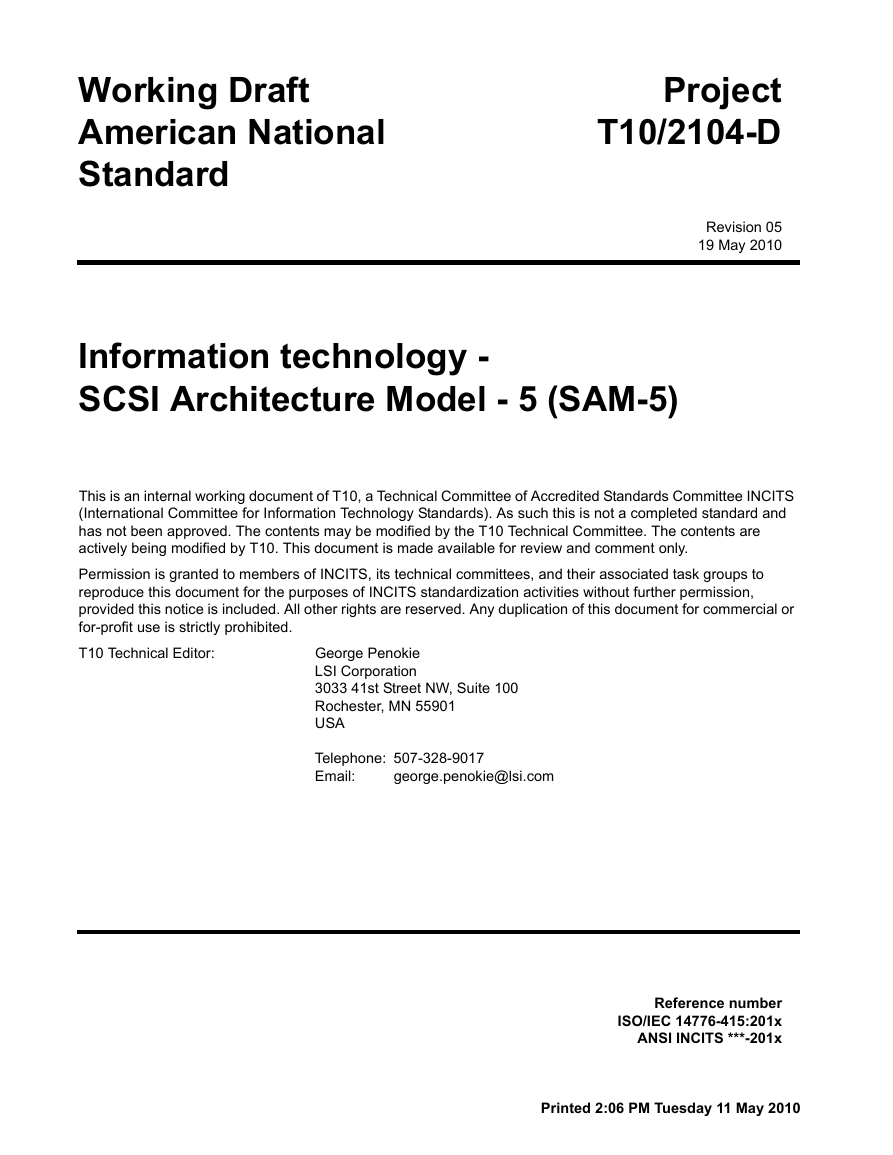
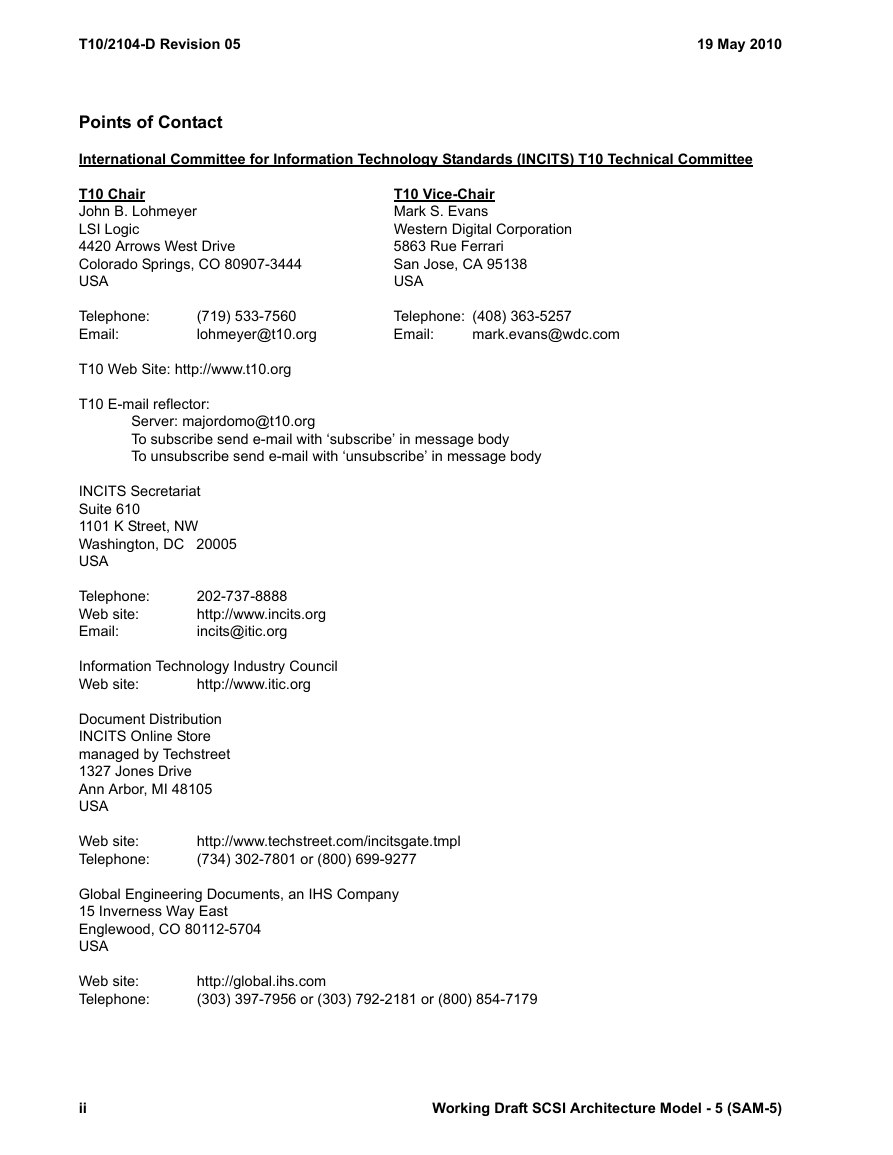
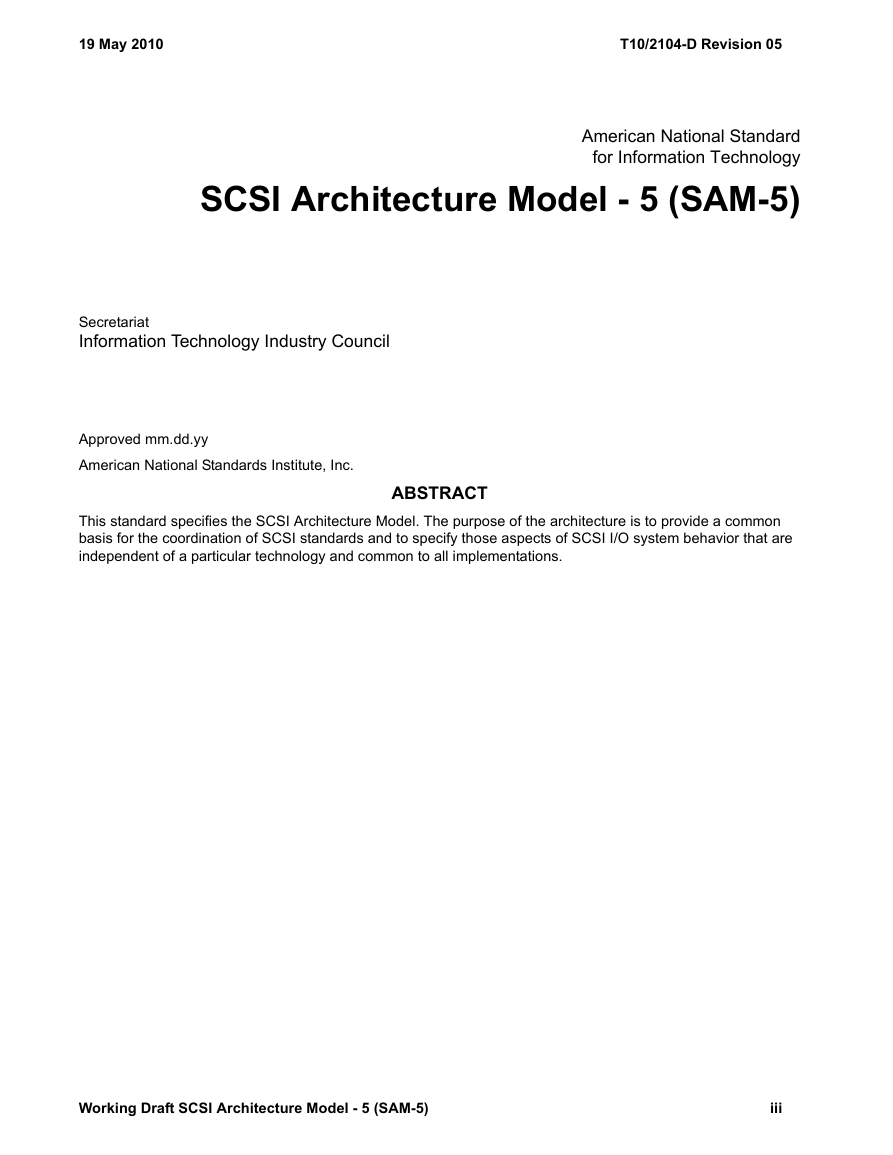
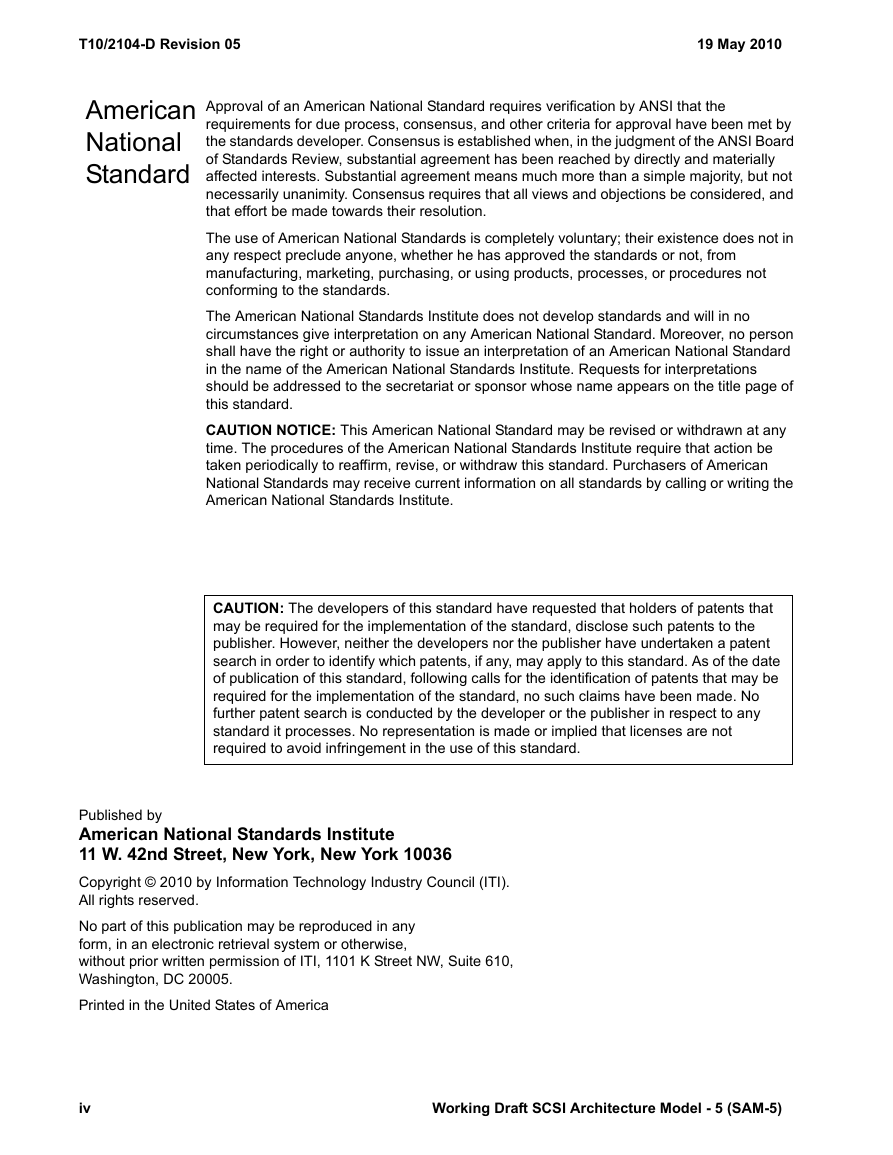
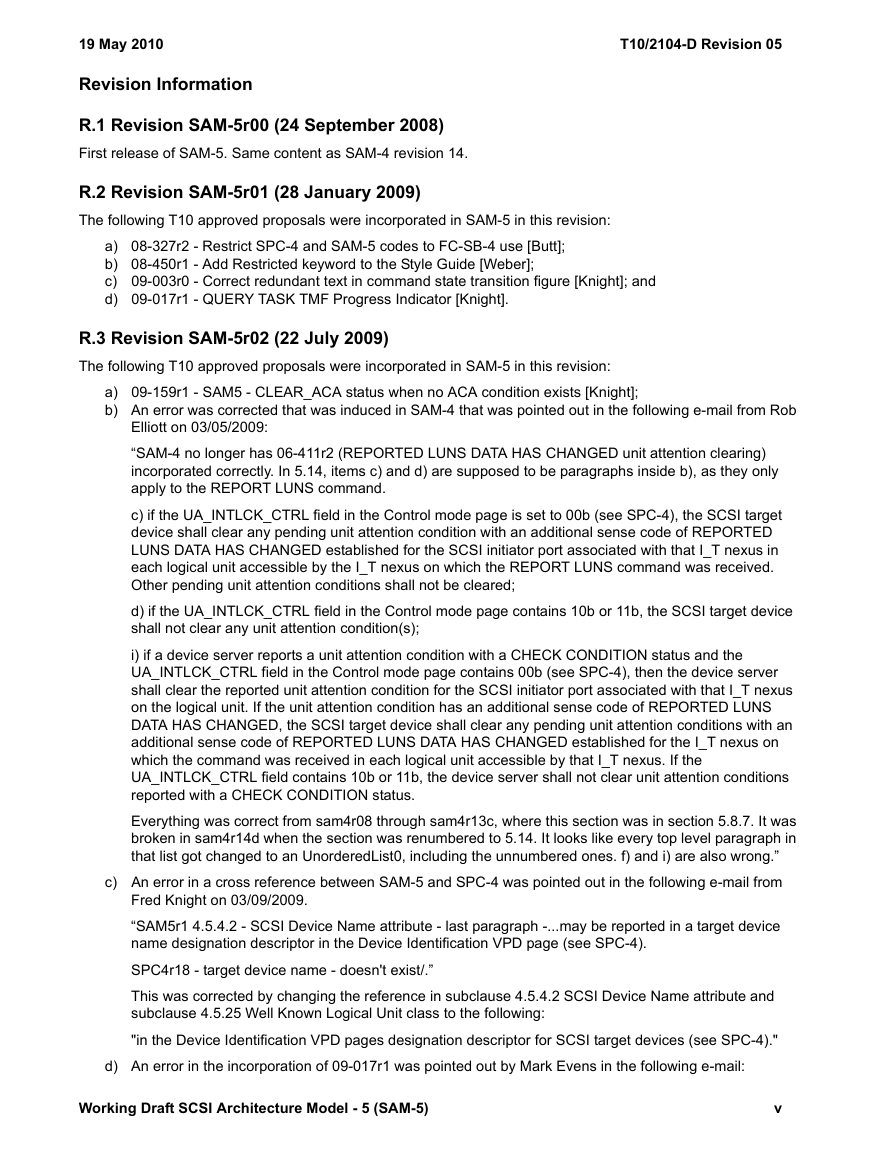
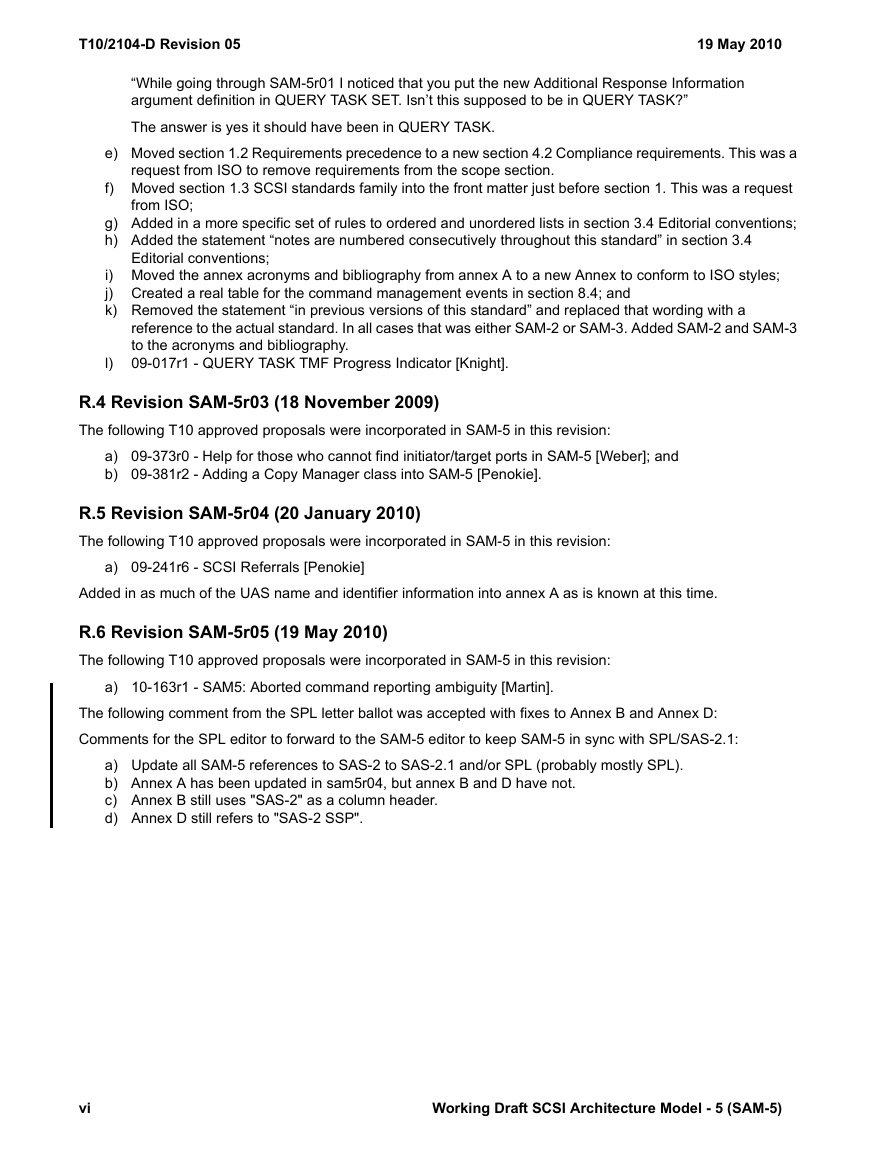
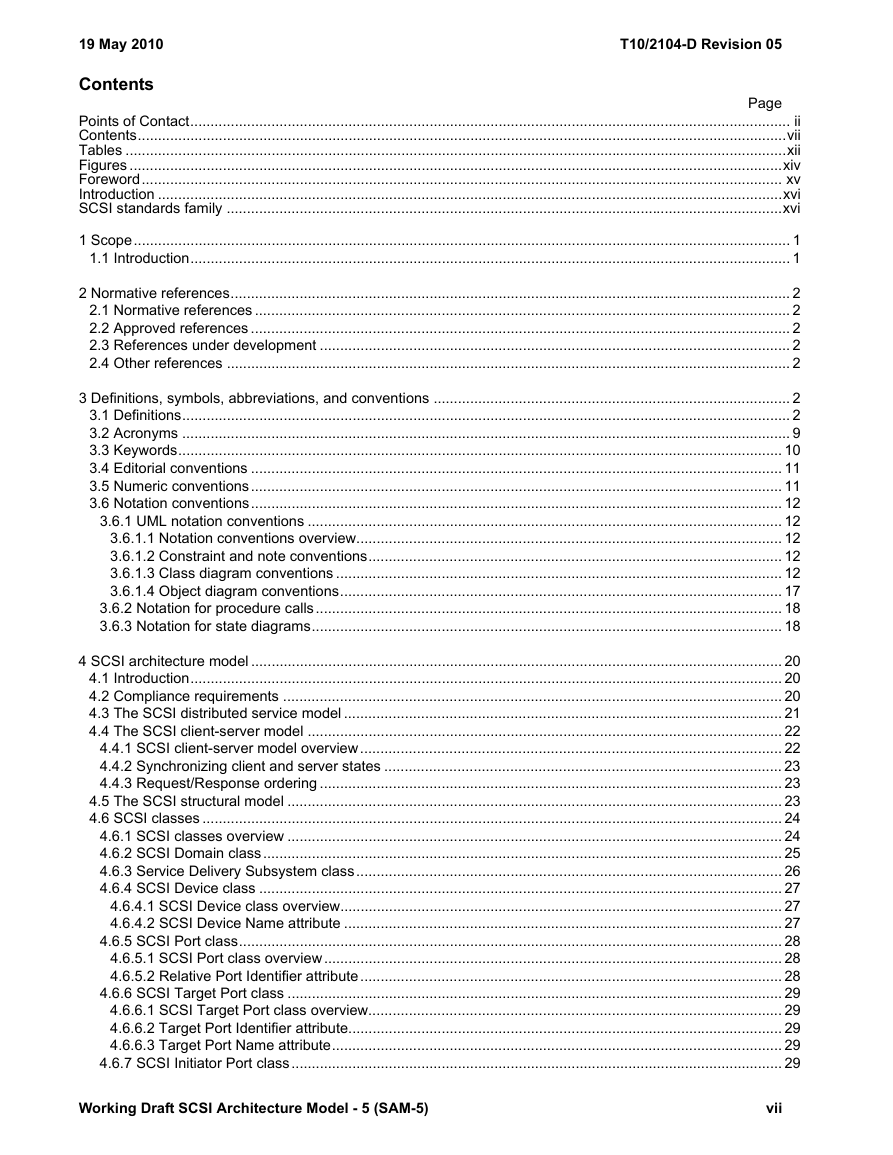
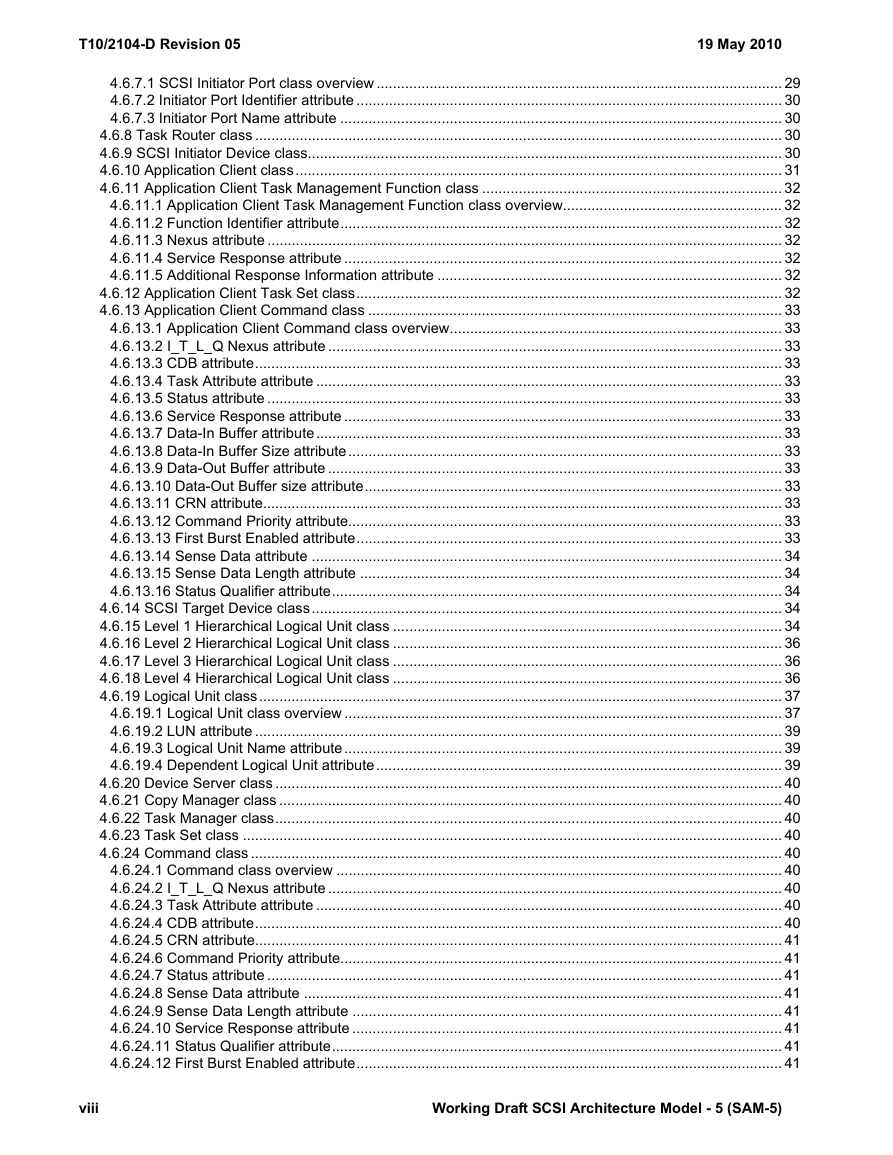








 2023年江西萍乡中考道德与法治真题及答案.doc
2023年江西萍乡中考道德与法治真题及答案.doc 2012年重庆南川中考生物真题及答案.doc
2012年重庆南川中考生物真题及答案.doc 2013年江西师范大学地理学综合及文艺理论基础考研真题.doc
2013年江西师范大学地理学综合及文艺理论基础考研真题.doc 2020年四川甘孜小升初语文真题及答案I卷.doc
2020年四川甘孜小升初语文真题及答案I卷.doc 2020年注册岩土工程师专业基础考试真题及答案.doc
2020年注册岩土工程师专业基础考试真题及答案.doc 2023-2024学年福建省厦门市九年级上学期数学月考试题及答案.doc
2023-2024学年福建省厦门市九年级上学期数学月考试题及答案.doc 2021-2022学年辽宁省沈阳市大东区九年级上学期语文期末试题及答案.doc
2021-2022学年辽宁省沈阳市大东区九年级上学期语文期末试题及答案.doc 2022-2023学年北京东城区初三第一学期物理期末试卷及答案.doc
2022-2023学年北京东城区初三第一学期物理期末试卷及答案.doc 2018上半年江西教师资格初中地理学科知识与教学能力真题及答案.doc
2018上半年江西教师资格初中地理学科知识与教学能力真题及答案.doc 2012年河北国家公务员申论考试真题及答案-省级.doc
2012年河北国家公务员申论考试真题及答案-省级.doc 2020-2021学年江苏省扬州市江都区邵樊片九年级上学期数学第一次质量检测试题及答案.doc
2020-2021学年江苏省扬州市江都区邵樊片九年级上学期数学第一次质量检测试题及答案.doc 2022下半年黑龙江教师资格证中学综合素质真题及答案.doc
2022下半年黑龙江教师资格证中学综合素质真题及答案.doc